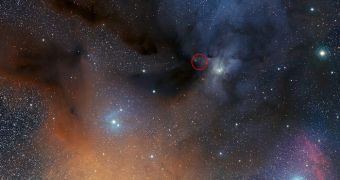An international collaboration of astronomers using the Chile-based APEX telescope managed to find a concentration of hydrogen peroxide in space. The chemical was never seen in interstellar space before.
With the new data, chemists and astrobiologists could deepen their understanding about how the two most important molecules for life – hydrogen and oxygen – are linked and interact with each other.
Down on Earth, the complex interplay between these two elements plays a critically important role in the production of both water and ozone. The latter chemical (O3) is what stands between lifeforms on the planet's surface and the devastating effects of exposure to ultraviolet radiation from the Sun.
Hydrogen peroxide is commonly used nowadays for the production of disinfectant substances, and for hair bleach products. But the Apex installation – which is operated by the European Southern Observatory – managed to discover it in space for the first time.
The telescope is found on the 5000-meter-high Chajnantor plateau, in the Chilean Andes. This position gives it an exquisite view of the night sky. Its full name is the Atacama Pathfinder Experiment (APEX).
Interestingly, the H2O2 was discovered very close to home, in the vicinity of the star Rho Ophiuchi. The object lies only 400 light-years away, and neighbors extremely cold and dense clouds of cosmic dust and hydrogen gas. Mean temperatures within dip as low as minus 250 degrees Celsius.
Due to their density and sheer size, portions of these clouds often collapse to ignite new protostars. In addition to hydrogen, other chemicals are present in these clouds as well, and APEX's millimeter- and submillimeter-wavelength capabilities can identify them precisely.
Spectrometric analysis of the light coming from the region near Rho Ophiuchi revealed the light signature of hydrogen peroxide, in a study that baffled scientists. “We were really excited to discover the signatures of hydrogen peroxide with APEX,” Per Bergman explains.
“We knew from laboratory experiments which wavelengths to look for, but the amount of hydrogen peroxide in the cloud is just one molecule for every ten billion hydrogen molecules, so the detection required very careful observations,” the expert adds.
The investigator is the lead author of a new study detailing the findings, which appears in the latest issue of the esteemed journal Astronomy & Astrophysics. Bergman holds an appointment as an astronomer at the Onsala Space Observatory, in Sweden.
Understanding the presence of hydrogen peroxide in space might eventually lead experts to new theories about how water arrived on Earth during its earliest days. “We don’t understand yet how some of the most important molecules here on Earth are made in space,” scientist Bérengère Parise explains.
He is a coauthor of the study, and also the head of the Emmy Noether research group on star formation and astrochemistry at the Max-Planck Institute for Radio Astronomy, in Germany.

 14 DAY TRIAL //
14 DAY TRIAL //